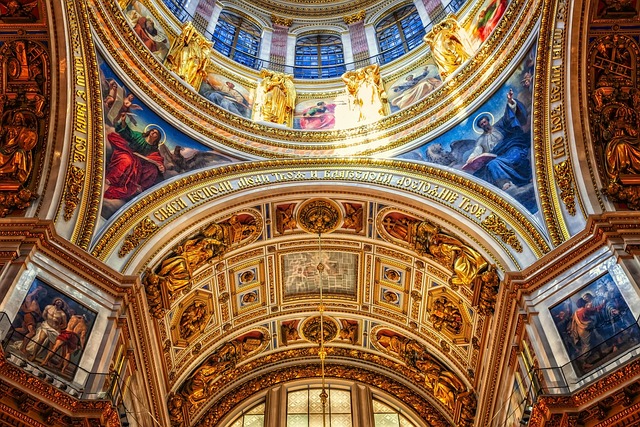An Orthodox Church service is a sacred and traditional worship experience that follows a rich and ancient liturgical tradition. It is characterized by its reverence, symbolism, and emphasis on the presence of God. The service is conducted in a solemn and structured manner, incorporating prayers, hymns, scripture readings, and sacraments. The Orthodox Church service aims to create a profound spiritual atmosphere, inviting worshippers to participate in the divine mysteries and encounter the transcendent presence of God.
Table of Contents
The Structure of an Orthodox Church Service
Have you ever wondered what an Orthodox Church service is like? If you’re unfamiliar with the traditions and rituals of the Orthodox Christian faith, attending a service can be a unique and enlightening experience. In this article, we will explore the structure of an Orthodox Church service and give you a glimpse into the rich and ancient traditions that are followed.
When you enter an Orthodox Church, you will immediately notice the beauty and reverence that permeates the space. The walls are adorned with icons, depicting saints and biblical scenes, and the air is filled with the scent of incense. The service begins with the chanting of prayers and hymns, creating a serene and meditative atmosphere.
The structure of an Orthodox Church service is deeply rooted in tradition and follows a specific order. The service is divided into two main parts: the Liturgy of the Word and the Liturgy of the Eucharist. These two parts are separated by the reading of the Gospel, which is considered the centerpiece of the service.
During the Liturgy of the Word, the priest and deacons read passages from the Old and New Testaments, as well as from the Psalms. These readings are accompanied by prayers and hymns, and the congregation stands in reverence. The purpose of this part of the service is to listen to the Word of God and reflect on its meaning.
After the readings, the Gospel is brought out in a procession, and the congregation stands as a sign of respect. The priest then reads from the Gospel, and the congregation listens attentively. This moment is considered a highlight of the service, as it represents the teachings of Jesus Christ.
Following the reading of the Gospel, the Liturgy of the Eucharist begins. This part of the service focuses on the sacrament of Holy Communion, where the bread and wine are consecrated and believed to become the body and blood of Christ. The priest leads the congregation in prayers and hymns, and the faithful approach the altar to receive Communion.
Throughout the service, the congregation participates actively by singing hymns, reciting prayers, and making the sign of the cross. The use of incense, candles, and icons adds to the sensory experience, creating a deeply spiritual atmosphere.
The Orthodox Church service is a communal experience, with the congregation standing together in prayer and worship. There is a sense of unity and reverence as the faithful come together to honor God and seek His blessings.
Attending an Orthodox Church service can be a transformative experience, even for those who are not part of the Orthodox Christian faith. The rich traditions, beautiful rituals, and deep spirituality create a sense of awe and wonder. Whether you are seeking a deeper connection with God or simply curious about different religious practices, an Orthodox Church service is worth experiencing.
In conclusion, an Orthodox Church service is a structured and reverent experience that follows a specific order. The Liturgy of the Word and the Liturgy of the Eucharist are the two main parts of the service, with the reading of the Gospel serving as the centerpiece. The congregation actively participates through prayers, hymns, and gestures, creating a sense of unity and reverence. Attending an Orthodox Church service can be a transformative and enlightening experience, offering a glimpse into the rich traditions and spirituality of the Orthodox Christian faith.
The Role of Icons in Orthodox Worship

When you walk into an Orthodox Church, one of the first things you’ll notice is the abundance of icons. These religious images are an integral part of Orthodox worship and play a significant role in the service. Icons are not just decorations; they are windows into the spiritual realm and serve as a means of connecting with God and the saints.
In Orthodox Christianity, icons are considered to be more than mere paintings or representations. They are believed to be a direct link between the earthly and heavenly realms. Icons are seen as windows into the divine, allowing believers to glimpse the spiritual reality beyond the physical world. This belief is rooted in the Orthodox understanding of the Incarnation, the belief that God became human in the person of Jesus Christ. Just as Christ is both fully God and fully human, icons are seen as both material and spiritual.
During an Orthodox Church service, icons are prominently displayed throughout the sanctuary. They can be found on the walls, in the iconostasis (a screen or wall of icons separating the sanctuary from the nave), and even on the ceiling. The placement of icons is intentional, with each one carefully chosen and positioned to create a sense of sacred space.
Icons are not worshipped in Orthodox Christianity, but they are venerated. This means that they are treated with great respect and honor. Orthodox believers will often kiss an icon as a sign of reverence, recognizing the presence of the divine within it. This act of veneration is not directed towards the physical object itself, but towards the person or event depicted in the icon. For example, when kissing an icon of Christ, believers are expressing their love and devotion to Jesus.
Icons are not limited to depictions of Christ; they also portray the Virgin Mary, the saints, and biblical events. Each icon has a specific purpose and meaning within the context of Orthodox worship. For example, icons of the Virgin Mary are often placed near the entrance of the church, symbolizing her role as the gate to heaven. Icons of the saints serve as reminders of their holy lives and inspire believers to follow their example.
In addition to their visual presence, icons are also an auditory element in Orthodox worship. Chanting and singing are an integral part of the service, and icons are often referenced in the hymns and prayers. The words and melodies of these hymns are carefully crafted to reflect the theology and spirituality of the Orthodox tradition. By incorporating icons into the liturgical music, believers are reminded of the sacred presence they represent.
Icons are not just static images; they are living witnesses to the divine. They invite believers to enter into a deeper relationship with God and the saints. Icons are a tangible expression of Orthodox spirituality, reminding believers of the eternal truths of the faith. So, the next time you attend an Orthodox Church service, take a moment to appreciate the icons and the role they play in connecting the earthly and heavenly realms.
The Importance of Chanting and Liturgical Music
When you step into an Orthodox Church, you are immediately enveloped in a rich and ancient tradition. The sights, sounds, and smells transport you to a different time and place. One of the most striking aspects of an Orthodox Church service is the chanting and liturgical music that fills the air.
Chanting has been an integral part of Orthodox worship since the early days of Christianity. It is a way for the congregation to participate actively in the service, offering their prayers and praises to God. The melodies are often simple and repetitive, allowing the worshippers to enter into a meditative state and focus their minds on the divine.
The music in an Orthodox Church service is not just for entertainment or decoration; it serves a higher purpose. It is a means of connecting with the divine and expressing the deep emotions and longings of the soul. The melodies are carefully chosen to reflect the mood and theme of the particular service or season of the Church calendar.
The music in an Orthodox Church service is not limited to just the human voice. Instruments such as the organ, bells, and cymbals are also used to enhance the worship experience. However, the human voice remains the primary instrument, as it is believed to be the most direct and personal way to communicate with God.
The chanting in an Orthodox Church service is not performed by professional musicians or choirs, but by the entire congregation. This is a unique aspect of Orthodox worship that sets it apart from other Christian traditions. Everyone is encouraged to participate, regardless of their musical ability. The goal is not to produce a perfect performance, but to offer a sincere and heartfelt offering of praise to God.
The words of the chants are taken from the Psalms, the Bible, and other sacred texts. They are carefully selected to convey the theological teachings and spiritual truths of the Orthodox faith. The melodies are often ancient and have been passed down through generations of worshippers. They have a timeless quality that connects the present-day congregation with the saints and martyrs of the past.
The chanting and liturgical music in an Orthodox Church service are not meant to be a performance or a form of entertainment. They are a form of prayer and worship, a way for the congregation to enter into communion with God. The melodies and words are meant to uplift the soul and draw the worshippers closer to the divine presence.
Attending an Orthodox Church service can be a transformative experience. The chanting and liturgical music create an atmosphere of reverence and awe, inviting the worshippers to enter into a deeper level of spiritual communion. Whether you are a lifelong Orthodox Christian or a curious visitor, the power of the music will leave a lasting impression on your heart and soul.
So, the next time you find yourself in an Orthodox Church, take a moment to listen to the chanting and liturgical music. Let the melodies and words wash over you, and allow yourself to be transported to a place of deep spiritual connection. You may find that the experience leaves you with a renewed sense of faith and a desire to explore the rich tradition of Orthodox worship further.
The Sacraments and Rituals in an Orthodox Church Service
The Orthodox Church is known for its rich and ancient traditions, and its worship services are no exception. Attending an Orthodox Church service can be a unique and awe-inspiring experience, especially for those who are unfamiliar with the rituals and sacraments that take place. In this article, we will explore the sacraments and rituals that are an integral part of an Orthodox Church service.
One of the most important sacraments in the Orthodox Church is the Eucharist, also known as Holy Communion. This sacrament is a central part of the Divine Liturgy, which is the main worship service in the Orthodox Church. During the Divine Liturgy, the bread and wine are consecrated and believed to become the body and blood of Christ. Orthodox Christians believe that partaking in the Eucharist is a way to unite with Christ and receive his grace.
Another significant sacrament in the Orthodox Church is baptism. Baptism is seen as the initiation into the Church and the washing away of sins. In an Orthodox Church service, baptism is typically performed by immersion in water three times, symbolizing the Holy Trinity. The person being baptized is anointed with holy oil and receives a white garment, symbolizing their new life in Christ.
In addition to the sacraments, there are various rituals and traditions that are observed in an Orthodox Church service. One of these rituals is the use of icons, which are religious images that depict Christ, the Virgin Mary, and the saints. Icons are venerated and treated with great respect in the Orthodox Church. During a service, you will often see people kissing and bowing before icons as a sign of reverence.
Another important ritual in an Orthodox Church service is the use of incense. Incense is used to symbolize the prayers of the faithful rising to heaven. The priest will often cense the altar, the icons, and the congregation during the service. The smell of incense creates a sense of holiness and adds to the overall atmosphere of worship.
Chanting is also a significant part of an Orthodox Church service. The music in the Orthodox Church is known for its beauty and complexity. The hymns and chants are sung in a cappella style, without the use of musical instruments. The melodies are often ancient and have been passed down through generations. The chanting creates a sense of reverence and helps to elevate the worship experience.
Throughout the service, there are various prayers and readings from the Bible. The priest will lead the congregation in prayer, and there are specific prayers for different parts of the service. The readings from the Bible are typically from the Old and New Testaments and are chosen to correspond with the theme of the day or the liturgical season.
Attending an Orthodox Church service can be a transformative experience. The sacraments and rituals that are observed create a sense of awe and reverence. Whether it is partaking in the Eucharist, witnessing a baptism, or experiencing the beauty of the chanting and incense, there is a deep sense of spirituality that permeates the service. If you have the opportunity, I highly recommend attending an Orthodox Church service to experience the sacraments and rituals firsthand.
Conclusion
In conclusion, an Orthodox Church service is characterized by its rich liturgical traditions, solemnity, and reverence. It involves a combination of prayers, scripture readings, hymns, and rituals, all performed with a deep sense of spirituality and devotion. The service is led by a priest and involves active participation from the congregation, who engage in standing, kneeling, and making the sign of the cross. The use of icons, incense, and chanting further enhances the worship experience. Overall, an Orthodox Church service is a deeply meaningful and sacred event for its followers.
For licensing reasons, we must provide the following notice: This content was created in part with the help of an AI.


